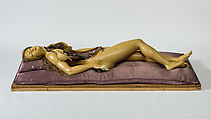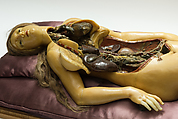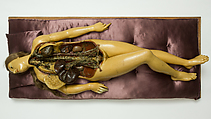Returned to lender The Met accepts temporary loans of art both for short-term exhibitions and for long-term display in its galleries.
Anatomical Venus
Fontana Workshop Italian
Not on view
An interest in human anatomy during the eighteenth century led to the production of female wax cadavers known as "anatomical Venuses." These hyperreal sculptures—with glistening skin, languid poses, and flowing hair—were designed for disassembly and exploration of the feminine interior and sex organs. Critics dismissed anatomical sculptures as peepshow science, though one Florentine practitioner, Clemente Susini, earned a sterling reputation for his superior wax modeling. This figure was produced in the workshop where Susini practiced, and it bears resemblance to his works that sit halfway between life and death, artwork and artifact, and science and erotica.
Due to rights restrictions, this image cannot be enlarged, viewed at full screen, or downloaded.
This artwork is meant to be viewed from right to left. Scroll left to view more.




